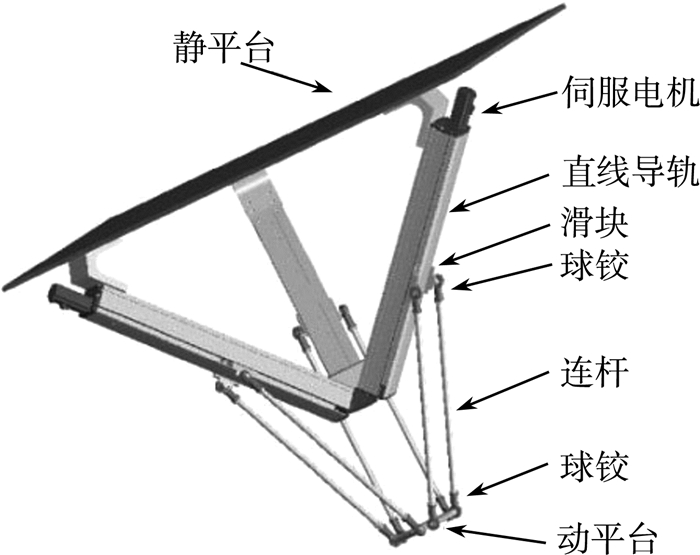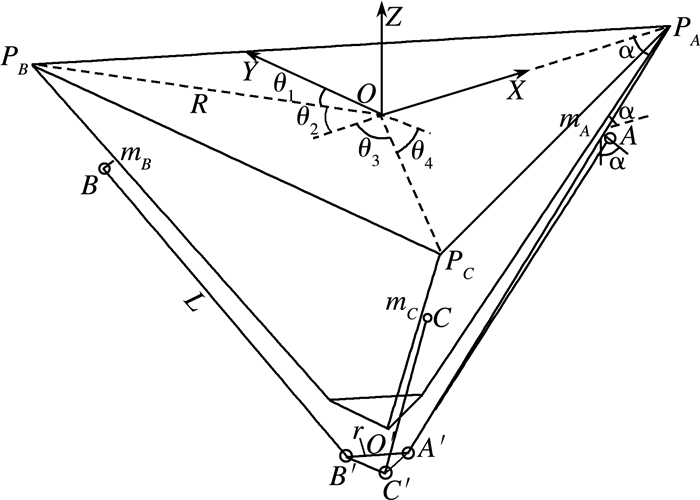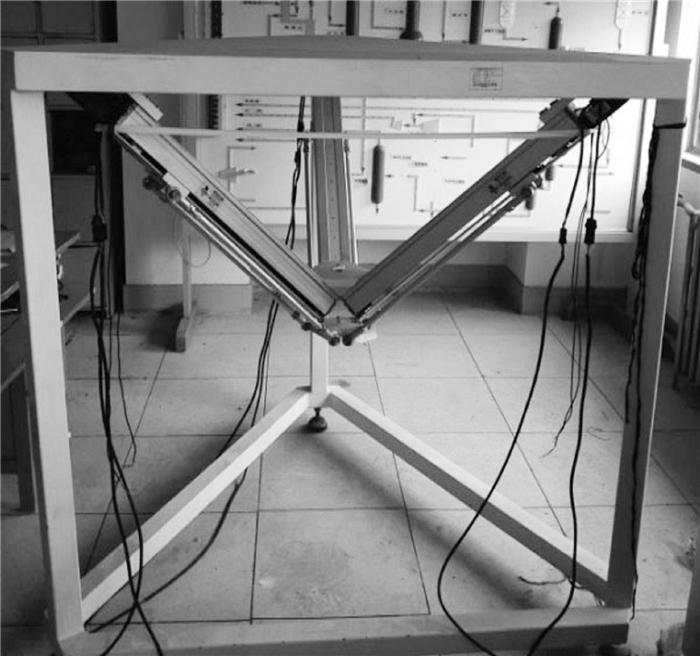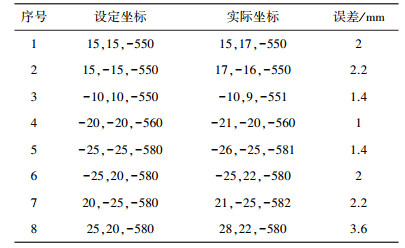| 直线型Delta机器人运动学分析 |
2. 齐鲁工业大学(山东省科学院) 机械与汽车工程学院,济南 250353
2. School of Mechanical and Automotive Engineering, Qilu University of Technology(Shandong Academy of Sciences), Jinan 250353, China
如图 1所示,Delta并联机器人具有运动控制精度高、刚度大、体积小[1-3]等显著优点,可以实现对轻小物件的快速抓取和放置[4]。运动分析是机器人应用的基础,目前对Delta系列机器人速度和加速度的分析,通常采用对位置方程的时间求导数的方法[5-9],但在实际计算过程中,该种方法通常伴随着复杂的坐标转换及矩阵运算,因而对读者知识水平要求较高。针对上述情况,采用一种基于坐标关系的求解方法[10]。相较于传统的基于位置关系的求解方法,该方法简化了分析运算过程,通过对约束条件的限定,有效解决了逆运动学分析多解的问题,并能较好的反应运动分析的数学本质,适合于初学者阅读。
 |
| 图 1 Delta机器人结构模型图 |
1 Delta机器人运动学分析 1.1 位置逆解
图 2为建立的空间直角坐标系。在该空间直角坐标系中,以三条直线导轨在静平台投影的交点作为坐标原点O,静平台与导轨的交点分别为PA、PB, PC。PA、PB、PC与O点的距离为R。静平台与导轨的夹角为α。滑块与导轨交点为mA、mB、mC,滑块与连杆的交点为A、B、C,滑块长度为l。动平台与连杆的交点为A′、B′、C′, 动平台中心用O′表示,A′、B′、C′与O′的距离为r。连杆的长度为L。B导轨与y轴正方向夹角为θ1,B导轨与x轴负方向夹角为θ2,C导轨与x轴负方向夹角为θ3,C导轨与y轴负方向夹角为θ4。其中:θ1=30°,θ2=60°,θ3=60°,θ4=30°,α=45°,R=615 mm,r=58 mm,L=600 mm,l=30 mm。
 |
| 图 2 Delta机器人空间直角坐标系 |
动平台中心O′用4×1列阵表示为:
| $ O' = {\left[ {\begin{array}{*{20}{c}} x&y&z&1 \end{array}} \right]^T}。$ |
动平台与连杆交点A′、B′、C′用矩阵分别表示为:
| $ A' = \left[ {\begin{array}{*{20}{c}} {{x_{A'}}}\\ {{y_{A'}}}\\ {{z_{A'}}}\\ 1 \end{array}} \right] = \left[ {\begin{array}{*{20}{c}} 1&0&0&r\\ 0&1&0&0\\ 0&0&1&0\\ 0&0&0&1 \end{array}} \right]\left[ {\begin{array}{*{20}{c}} x\\ y\\ z\\ 1 \end{array}} \right] = \left[ {\begin{array}{*{20}{c}} {x + r}\\ y\\ z\\ 1 \end{array}} \right]。$ |
同理可得:
| $ B' = \left[ {\begin{array}{*{20}{c}} {{x_{B'}}}\\ {{y_{B'}}}\\ {{z_{B'}}}\\ 1 \end{array}} \right] = \left[ {\begin{array}{*{20}{c}} {x - r\cos {\theta _2}}\\ {y + r\cos {\theta _1}}\\ z\\ 1 \end{array}} \right]。$ |
同理可以求得滑块与连杆的交点A, B, C的空间位置矩阵:
| $ C' = \left[ {\begin{array}{*{20}{c}} {{x_{C'}}}\\ {{y_{C'}}}\\ {{z_{C'}}}\\ 1 \end{array}} \right] = \left[ {\begin{array}{*{20}{c}} {x - r\cos {\theta _3}}\\ {y - r\cos {\theta _4}}\\ z\\ 1 \end{array}} \right]。$ |
同理可以求得滑块与连杆的交点A, B, C的空间位置矩阵:
| $ A = \left[ {\begin{array}{*{20}{c}} {R - {m_1}\cos \alpha + l\sin \alpha }\\ 0\\ { - {m_1}\sin \alpha - l\cos \alpha }\\ 1 \end{array}} \right], $ |
| $ B = \left[ {\begin{array}{*{20}{c}} { - R\cos {\theta _2} + {m_2}\cos \alpha \cos {\theta _2} - l\sin \alpha \cos {\theta _2}}\\ {R\cos {\theta _1} - {m_2}\cos \alpha \cos {\theta _1} + l\sin \alpha \cos {\theta _1}}\\ { - {m_2}\sin \alpha - l\cos \alpha }\\ 1 \end{array}} \right], $ |
| $ C = \left[ {\begin{array}{*{20}{c}} { - R\cos {\theta _3} + {m_3}\cos \alpha \cos {\theta _3} - l\sin \alpha \cos{\theta _3}}\\ { - R\cos {\theta _4} + {m_3}\cos \alpha \cos {\theta _4} - l\sin \alpha \cos{\theta _4}}\\ { - {m_3}\sin \alpha - l\cos \alpha }\\ 1 \end{array}} \right]。$ |
由连杆的长度为定值L得:
| $ \left| {AA'} \right| = L, $ | (1) |
| $ \left| {BB'} \right| = L, $ | (2) |
| $ \left| {CC'} \right| = L。$ | (3) |
将各参数代入(1)(2)(3)式得:
| $ \begin{array}{l} \left[ {\left( {R - {m_1}\cos \alpha + l\sin \alpha } \right) - \left( {x + r} \right)} \right]2 + \\ {y^2} + \left[ {\left( { - {m_1}\sin \alpha - l\cos \alpha } \right) - z} \right]2 = {L^2}, \end{array} $ | (4) |
| $ \begin{array}{l} \left[ {\left( { - R\cos {\theta _2} + {m_2}\cos \alpha \cos {\theta _2} - l\sin \alpha \cos {\theta _2}} \right) - \left( {x - } \right.} \right.\\ {\left. {\left. {r\cos {\theta _2}} \right)} \right]^2} + \left[ {\left( {R\cos {\theta _1} - {m_2}\cos \alpha \cos {\theta _1} + l\sin \alpha \cos {\theta _1}} \right)} \right.\\ {\left. { - \left( {y + r\cos {\theta _1}} \right)} \right]^2} + \left[ {\left( { - {m_2}\sin \alpha - l\cos \alpha } \right) - z} \right]2 = {L^2}, \end{array} $ | (5) |
| $ \begin{array}{l} \left[ {\left( { - R\cos {\theta _3} + {m_3}\cos \alpha \cos {\theta _3} - l\sin \alpha \cos {\theta _3}} \right) - \left( {x - } \right.} \right.\\ {\left. {\left. {r\cos {\theta _3}} \right)} \right]^2} + \left[ {\left( { - R\cos {\theta _4} + {m_3}\cos \alpha \cos {\theta _4} - } \right.} \right.\\ {\left. {\left. {l\sin \alpha \cos {\theta _4}} \right) - \left( {y - r\cos {\theta _4}} \right)} \right]^2} + \left[ {\left( { - {m_3}\sin \alpha - l\cos \alpha } \right)} \right.\\ \left. { - z} \right]2 = {L^2}. \end{array} $ | (6) |
推算速度雅可比矩阵时,分别将(4)、(5)、(6)式展开,并作全微分及等式两边同时除以得:
| $ \begin{array}{l} \left( {2{m_1} + 2r\cos \alpha - 2R\cos \alpha + 2x\cos \alpha + 2z\sin \alpha } \right)\\ \frac{{d{m_1}}}{{dt}} = \left( {2R + 2l\sin \alpha - 2{m_1}\cos \alpha - 2x - 2r} \right)\frac{{dx}}{{dt}} - 2y\frac{{dy}}{{dt}}\\ + \left( { - 2{m_1}\sin \alpha - 2z - 2l\cos \alpha } \right)\frac{{dz}}{{dt}}, \end{array} $ |
| $ \begin{array}{l} \left[ {2{m_2} + 2\left( {r\cos {\theta _2} - R\cos {\theta _2} - l\sin \alpha \cos{\theta _2}} \right)\cos \alpha \cos {\theta _2}} \right.\\ - 2\left( {R\cos {\theta _1} + l\sin \alpha \cos {\theta _1} - r\cos {\theta _1}} \right)\cos \alpha \cos {\theta _1} + \\ \left. {2l\cos \alpha \sin \alpha - 2x\cos \alpha \cos {\theta _2} + 2y\cos \alpha \cos {\theta _1} + 2z\sin \alpha } \right]\frac{{d{m_2}}}{{dt}}\\ = \left[ {2{m_2}\cos \alpha \cos {\theta _2} - 2x + 2\left( {r\cos {\theta _2} - R\cos {\theta _2} - } \right.} \right.\\ \left. {\left. {l\sin \alpha \cos{\theta _2}} \right)} \right]\frac{{dx}}{{dt}} + \left[ {2\left( {R\cos {\theta _1} + l\sin \alpha \cos {\theta _1} - r\cos {\theta _1}} \right) - } \right.\\ \left. {2{m_2}\cos \alpha \cos {\theta _1} - 2y} \right]\frac{{dy}}{{dt}} + \left( { - 2{m_2}\sin \alpha - 2z - } \right.\\ \left. {2l\cos \alpha } \right)\frac{{dz}}{{dt}}, \end{array} $ |
| $ \begin{array}{l} \left[ {2{m_3} + 2\left( {r\cos {\theta _3} - R\cos {\theta _3} - } \right.} \right.\\ \left. {l\sin \alpha \cos{\theta _3}} \right)\cos \alpha \cos {\theta _3} + 2\left( {r\cos {\theta _4} - R\cos {\theta _4} - } \right.\\ \left. {l\sin \alpha \cos{\theta _4}} \right)\cos \alpha \cos {\theta _4} + 2l\cos \alpha \sin \alpha - 2x\cos \alpha \cos {\theta _3} - \\ \left. {2y\cos \alpha \cos {\theta _4} + 2z\sin \alpha } \right]\frac{{d{m_3}}}{{dt}} = \left[ {2{m_3}\cos \alpha \cos {\theta _3} - 2x + } \right.\\ \left. {2\left( {r\cos {\theta _3} - R\cos {\theta _3} - l\sin \alpha \cos {\theta _3}} \right)} \right]\frac{{dx}}{{dt}} + \\ \left[ {2{m_3}\cos \alpha \cos {\theta _4} + 2\left( {r\cos {\theta _4} - R\cos {\theta _4} - l\sin \alpha \cos{\theta _4}} \right) - } \right.\\ \left. {2y} \right]\frac{{dy}}{{dt}} + \left( { - 2{m_3}\sin \alpha - 2z - 2l\cos \alpha } \right)\frac{{dz}}{{dt}}。\end{array} $ |
将上式中各变量系数以字母表示,即得:
| $ \left\{ \begin{array}{l} {{\dot m}_1} = \frac{{{B_1}}}{{{A_1}}}\dot x + \frac{{{C_1}}}{{{A_1}}}\dot y + \frac{{{D_1}}}{{{A_1}}}\dot z\\ {{\dot m}_2} = \frac{{{B_2}}}{{{A_2}}}\dot x + \frac{{{C_2}}}{{{A_2}}}\dot y + \frac{{{D_2}}}{{{A_2}}}\dot z\\ {{\dot m}_3} = \frac{{{B_3}}}{{{A_3}}}\dot x + \frac{{{C_3}}}{{{A_3}}}\dot y + \frac{{{D_3}}}{{{A_3}}}\dot z \end{array} \right.。$ |
表述为矩阵形式即为:
| $ \left[ {\begin{array}{*{20}{c}} {{{\dot m}_1}}\\ {{{\dot m}_2}}\\ {{{\dot m}_3}} \end{array}} \right] = \left[ {\begin{array}{*{20}{c}} {\frac{{{B_1}}}{{{A_1}}}}&{\frac{{{C_1}}}{{{A_1}}}}&{\frac{{{D_1}}}{{{A_1}}}}\\ {\frac{{{B_2}}}{{{A_2}}}}&{\frac{{{C_2}}}{{{A_2}}}}&{\frac{{{D_2}}}{{{A_2}}}}\\ {\frac{{{B_3}}}{{{A_3}}}}&{\frac{{{C_3}}}{{{A_3}}}}&{\frac{{{D_3}}}{{{A_3}}}} \end{array}} \right]\left[ {\begin{array}{*{20}{c}} {\dot x}\\ {\dot y}\\ {\dot z} \end{array}} \right]。$ | (7) |
令:G为系数矩阵,将(7)式等式两边同时乘以G-1即得:
| $ {{\dot X}_n} = J\dot m。$ | (8) |
式中:
| $ {{\dot X}_n} = \left[ {\begin{array}{*{20}{c}} {\dot x}\\ {\dot y}\\ {\dot z} \end{array}} \right], $ |
表示动平台的空间移动速度
| $ \dot m = \left[ {\begin{array}{*{20}{c}} {{{\dot m}_1}}\\ {{{\dot m}_2}}\\ {{{\dot m}_3}} \end{array}} \right], $ |
表示各轴进给速度列向量
| $ J = {\left[ {\begin{array}{*{20}{c}} {\frac{{{B_1}}}{{{A_1}}}}&{\frac{{{C_1}}}{{{A_1}}}}&{\frac{{{D_1}}}{{{A_1}}}}\\ {\frac{{{B_2}}}{{{A_2}}}}&{\frac{{{C_2}}}{{{A_2}}}}&{\frac{{{D_2}}}{{{A_2}}}}\\ {\frac{{{B_3}}}{{{A_3}}}}&{\frac{{{C_3}}}{{{A_3}}}}&{\frac{{{D_3}}}{{{A_3}}}} \end{array}} \right]^{ - 1}}, $ |
即为速度雅可比矩阵。
1.3 Delta机器人加速度分析对(7)式求二次导数,即得:
| $ \ddot m = \dot G{{\dot X}_n} + G{{\ddot X}_n}, $ | (8) |
即:
| $ {{\ddot X}_n} = {\rm{J}}\left( {\ddot m - \dot G{{\dot X}_n}} \right)。$ | (9) |
式中,
| $ {{\ddot X}_n} = \left[ {\begin{array}{*{20}{c}} {\ddot x}\\ {\ddot y}\\ {\ddot z} \end{array}} \right], $ |
表示动平台空间移动加速度,
| $ \ddot m = \left[ {\begin{array}{*{20}{c}} {{{\ddot m}_1}}\\ {{{\ddot m}_2}}\\ {{{\ddot m}_3}} \end{array}} \right], $ |
表示各轴进给加速度列向量。
| $ \dot G = \left[ {\begin{array}{*{20}{c}} {\frac{{{{\dot B}_1}}}{{{A_1}}}}&{\frac{{{{\dot C}_1}}}{{{A_1}}}}&{\frac{{{{\dot D}_1}}}{{{A_1}}}}\\ {\frac{{{{\dot B}_2}}}{{{A_2}}}}&{\frac{{{{\dot C}_2}}}{{{A_2}}}}&{\frac{{{{\dot D}_2}}}{{{A_2}}}}\\ {\frac{{{{\dot B}_3}}}{{{A_3}}}}&{\frac{{{{\dot C}_3}}}{{{A_3}}}}&{\frac{{{{\dot D}_3}}}{{{A_3}}}} \end{array}} \right], $ |
即为加速度雅可比矩阵。
2 运动学验证为了对算法的准确性进行验证,采用如图 3所示的Delta机器人进行验证,实验结果如表 1所示。实验表明,最大误差不超过4 mm。验证了算法的正确性。
 |
| 图 3 线型Delta并联机器人 |
| 表 1 数据采样及误差 |
 |
误差原因分析及补偿:1)导轨在静平台的投影夹角不是严格的120°角;2)静平台与导轨的夹角不是严格的45°角;3)三条轴不是严格的对称结构,存在导轨及连杆长度不一的情况;4)测量存在误差。基于以上原因,在代码中对竖坐标作30 mm的误差补偿以减小误差,部分代码如下:
| $ {\rm{M21}} = {\rm{eq1}}\left( {{\rm{x}},{\rm{y}},{\rm{z}} + {\rm{30}}} \right); $ |
| $ {\rm{M22}} = {\rm{eq2}}\left( {{\rm{x}},{\rm{y}},{\rm{z}} + {\rm{30}}} \right); $ |
| $ {\rm{M23}} = {\rm{eq3}}\left( {{\rm{x}},{\rm{y}},{\rm{z}} + {\rm{30}}} \right)。$ |
针对Delta机器人运动分析较少、运算过程复杂、抽象的现象,介绍了一种新的计算方法。该种方法相较传统方法更加简洁且较好地诠释了运动分析的数学本质,因而具有一定的参考价值。
| [1] |
梁香宁, 牛志刚. 三自由度Delta并联机器人运动学分析及工作空间求解[J]. 太原理工大学学报, 2008, 39(1): 93. |
| [2] |
宫赤坤, 熊吉光, 黄成林. Delta并联机器人运动学与动力学仿真分析[J]. 制造业自动化, 2013, 35(3): 34. |
| [3] |
郑坤明, 张秋菊. 针对高速Delta机器人杆件优化的研究[J]. 机械传动, 2016, 40(1): 21. |
| [4] |
陈润超, 何建玲, 徐贵阳. 浅析Delta并联机器人的从动臂[J]. 机械传动, 2013, 37(5): 54. |
| [5] |
冯李航, 张为公, 龚宗洋, 等. Delta系列并联机器人研究进展与现状[J]. 机器人, 2014, 36(3): 377. |
| [6] |
毛洪国. 基于动力学模型的Delta机器人运动控制研究[D]. 哈尔滨: 哈尔滨工业大学, 2014. http://cdmd.cnki.com.cn/article/cdmd-10213-1014084089.htm
|
| [7] |
葛晓楠, 单东日. 直线驱动型Delta并联机器人运动学研究[J]. 燕山大学学报, 2016, 40(5): 409-410. |
| [8] |
葛晓楠. 基于视觉的并联机器人废纸杂志识别跟踪研究[D]. 济南: 齐鲁工业大学, 2016. http://cdmd.cnki.com.cn/Article/CDMD-10431-1016321128.htm
|
| [9] |
肖南峰. 工业机器人[M]. 北京: 机械工业出版社, 2011.
|
| [10] |
刘极峰. 机器人技术基础[M]. 北京: 高等教育出版社, 2012.
|
 2018, Vol. 32
2018, Vol. 32


